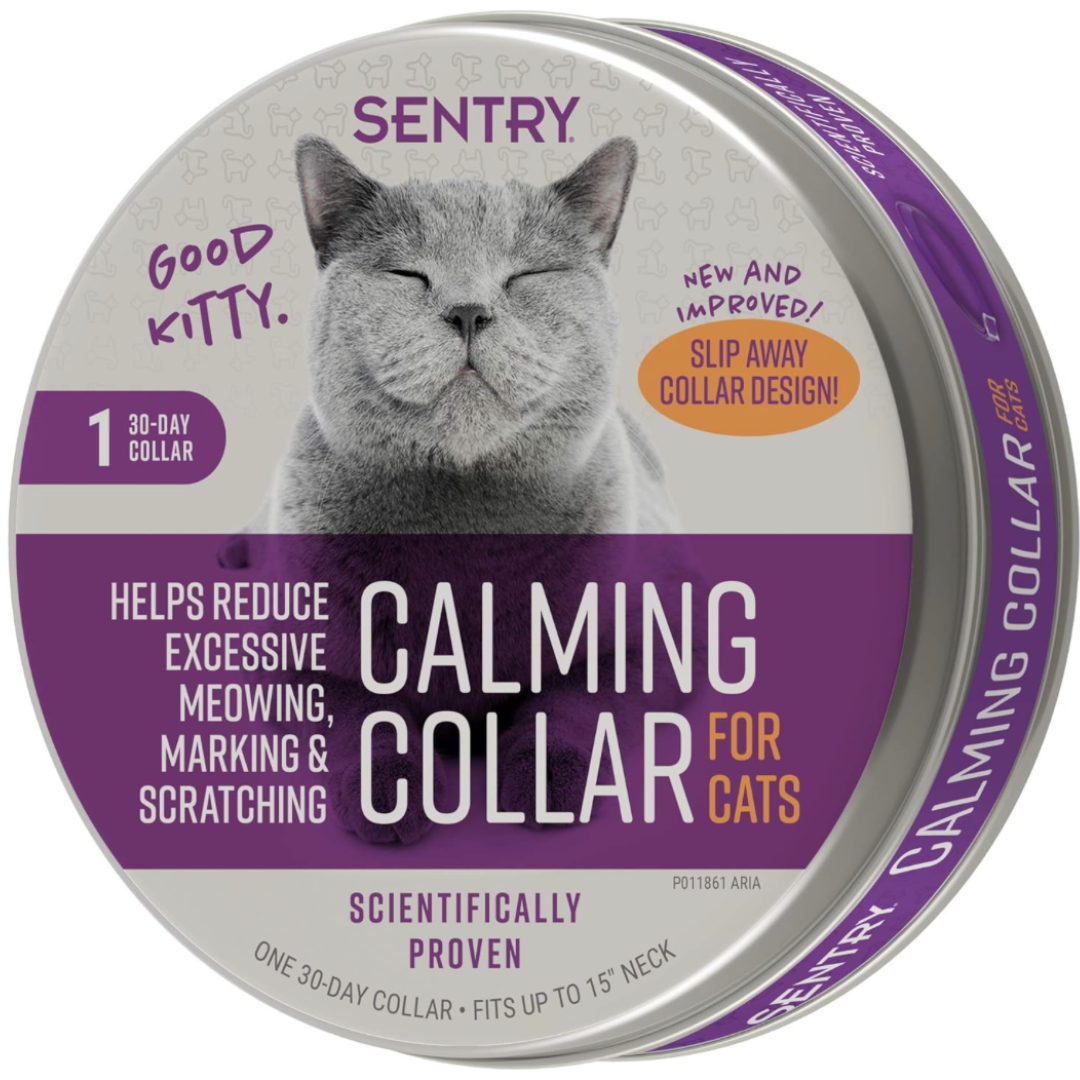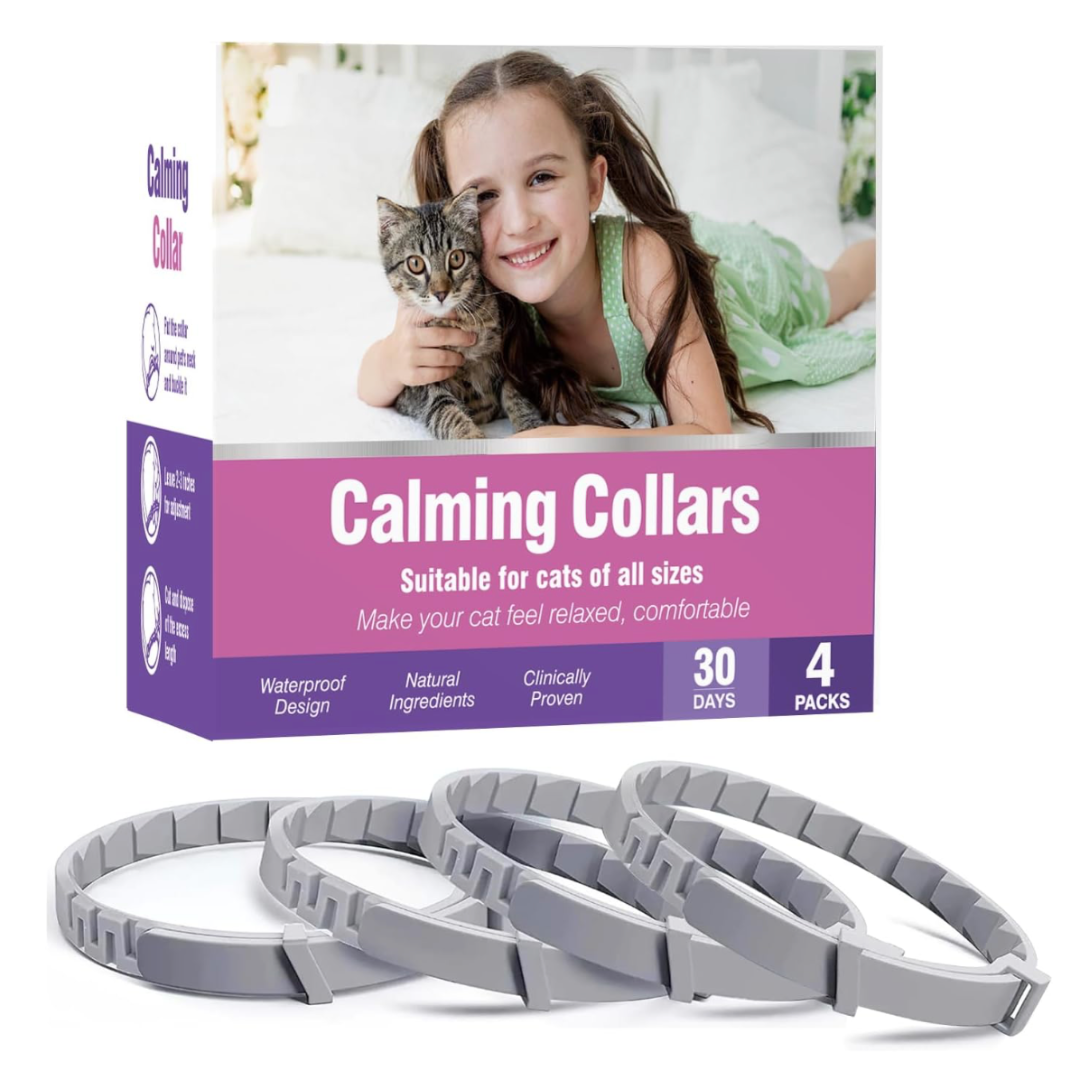Best calming cat collars 2025 to help ease anxiety
Do calming cat collars really reduce stress and anxiety and lead to a happy kitty?

The best calming cat collars may well be top of your shopping list if you have a feline friend who’s prone to feeling stressed, anxious or unsettled due to loud noises, travel, vet visits, relocation or any other event that causes a change in their routine.
As you probably know, cats are creatures of habit. They like their bowl replenished with the best cat food at roughly the same each day, they expect to be able to get hours of quiet and uninterrupted beauty sleep without fireworks or thunderstorms starling them awake, they want to know that their litter box will be in the same location it always is when they come to use it and that you’ll play with them regularly.
When these things don’t happen, our kitty companions can become very stressed very quickly and believe it or not, anxiety in cats is more common than you might think. That’s where calming cat collars can come in handy. Unlike the best flea collars for cats, these won’t keep pesky parasites at bay so be sure to pair them with a topical flea treatment, however the combination of essential oils and pheromones has been shown to be effective in helping some cats to feel calmer.
Below, we’ve rounded up a selection of calming cat collars, including waterproof and reflective options for outdoor cats and some affordable multi-buy options that will last you for months. Plus, we spoke to expert vet Dr. Hannah Godfrey to get her thoughts on whether calming collars actually work and how long your kitty can wear one for.
The best calming cat collars 2025

Best calming cat collar overall
The Relaxiv Calming Collar is designed to have a calming effect on your cat's nerves and is said to be effective at reducing all sorts of problematic behaviors from fighting and urine marking to scratching and hiding. We gave it to our experienced pet parent Dave who put it to the test with his kitty, Nova.
"Nova, seemed to like the smell of this purple-colored collar. As soon as it came out of the packet, he began to sniff it and, despite not usually being a collar-wearer, he had no qualms trying it on for size."
But were the lavender and chamomile essential oils effective at promoting relaxation? Nova seemed to think so. "Whether it was due to the heat of summer or the collar, he seemed rather chilled within a couple of hours and more willing to come up to us in the garden which he traditionally feels is his domain. He then fell asleep!," Dave told us.
The collar was also simple to fit and can be trimmed to fit smaller cats. "Although it felt a tad plasticky, it was just a matter of unfolding it, placing it around Nova's neck and fastening it using the buckle. In our case, we didn't need to remove any excess but this could easily be cut away."
Reasons to buy: Vet-reviewed and recommended, drug-free, effective, easy to use.
Reasons to avoid: Needs to be replaced every 30 days, no quick-release feature, strong odor.

Best budget buy
If you're looking to get more bang for your buck, the Weewooday 5 Set Calming Collar for Cats is a great choice. Adjustable up to 15-inches, this collar is suitable for all felines and is flexible and soft to wear.
Clinically proven to effectively reduce stress across a wide range of situations (including fireworks, vet visits, relocation, storms and travel), the collar starts working within an hour and is effective for up to 60-days.
We gave this collar to our tester Dave to try out on his cat Nova and aside from the strong smell (a by-product of the lavender oil), he felt the collar did what it says on the tin. "Nova seemed more relaxed and friendlier than normal," he reported.
Durable and waterproof, Dave feels this inexpensive pack of five collars is an absolute bargain, but once again the lack of a quick-release feature does concern him given that Nova is allowed outdoors. However, if you have an indoor cat, he says this would be much less of an issue.
Reasons to buy: Fantastic value for money, clinically proven to be effective in a wide range of situations, vet-approved, long-lasting, waterproof and weatherproof.
Reasons to avoid: Some users found the smell to be very overpowering.

Best quick-release collar
Scientifically proven to help reduce excessive meowing, scratching and marking, plus reduce the fear of loud noises and other stressful and unsettling events, the Sentry Calming Collar won over our feline tester Nova — and her Dad!
"The pheromone levels are higher in comparison to many other collars and the soft foamy feel to the collar reassured us that Nova would enjoy wearing it (and this was indeed the case)," Dave told us.
Perhaps the biggest draw with this collar is that it's designed to be quick release, which Dave said was a "major plus" in his book and offers great peace of mind if you have an outdoor cat whose adventures tend to take them under hedges and gates.
Neatly packaged in a handy tin that contains three collars, the sustained pheromone release lasts for 30 days and many pet parents have reported seeing a dramatic improvement in their cat's stress and anxiety levels after just a few days.
Reasons to buy: Quick-release design makes it safe for outdoor cats, higher pheromone level than other brands, gentle on the skin, easy to fit.
Reasons to avoid: Some users report that their cat was able to remove the collar.

Best waterproof collar
Offering great value for money, this calming collar comes in a pack of four with each collar being individually packaged to retain its potency and effectiveness. Designed to imitate the calming pheromone produced by a mother cat, it's a helpful tool when it comes to reducing tension and anxiety.
Designed to start working as quickly as an hour after it's been fitted, the collar can relieve stress caused by a variety of unsettling situations, including relocation, separation anxiety, loneliness and travel.
Providing up to 30 days of sustained pheromone release, the collar is waterproof meaning it will remain effective even if your cat gets wet. Containing natural lavender and chamomile essential oils, it's safe, comfortable and non-toxic and the flexible and adjustable sizing makes it suitable for cats of all sizes.
As with many calming collars on the market, this one does not come with a quick-release function and because of that we would not recommend it for cats who have unrestricted access to the great outdoors. However, for indoor-dwelling cats, this well-reviewed collar is well worth a try.
Reasons to buy: Affordable four-pack, waterproof, fast acting, users report that it works well.
Reasons to avoid: Lack of a quick-release function.

Best for outdoor cats
If you have a feline friend who has unrestricted access to nature's backyard, then this is our top pick for a calming collar.
With unique luminescent technology, it's a brilliant choice for helping to ensure your kitty stays visible during those early morning and late night hours. Simply expose the collar to light for five minutes before fitting it and it will glow continuously to help your cat stay safe in darker conditions.
The collar also comes with an emergency breaking point which means it will release and fall off your cat if they get stuck while going under a hedge or gate.
Adjustable, lightweight and comfortable to wear, the collar contains calming essential oils that get to work within an hour of your cat wearing the collar and last for up to 60 days. Plus, they come in a handy pack of four and are super affordable.
Reasons to buy: Glow in the dark, breakaway feature, long lasting, waterproof, budget-friendly.
Reasons to avoid: Some users report that this collar wasn't effective at calming their cats down.
How do cat calming collars work?
The most effective cat calming collars are those which contain pheromones – or, to be precise, synthetic reproductions of the calming, safe-marking pheromones released by cats. These odorless and colorless chemicals are usually produced naturally by a feline's body as a method of communication. Cats receive them via the vomeronasal organ (or Jacobson's organ as it's also known) which is located in the roof of their mouth.
When a cat collar comes into close contact with a feline's skin, it releases the artificial pheromones contained within it. These pheromones can be continuously emitted for up to 30 days, triggering a calm response within the cat.
But that's not the full story. Cat calming collars can also contain herbs and essential oils, sometimes in combination with pheromones and sometimes without. Again, these are released when the collar is close to the skin, but whether or not they have the same calming effect is debatable.
Remember, calming cat collars do not offer protection against parasites, so we recommend you pair the collar with one of the best flea treatments for cats.
Are cat calming collars effective?

When it comes to how to calm a cat during periods of high anxiety, a calming cat collar is well worth a try.
"There are lots of cat calming collars available, and whether they work effectively depends on their ingredients and your particular cat," explains Dr. Godfrey.
"Most contain either valerian or feline pheromones, which can be helpful in making your cat feel calmer. However, even in my own experiences with cat calming products – one of my cats in particular was much more sensitive to valerian than he was to pheromones.
Unfortunately, with these things, there’s no guarantee they’ll be effective enough to cope with major stresses, like fireworks or new pets, but they can be helpful in a lot of cases, even if you need to use other methods too."
How long can a cat wear a calming collar?
"Each collar will have a recommendation for how long they are effective – for most it will be around 4-6 weeks," says Dr. Godfrey. "However, since they work by concentrating the calming compounds in the air around your cat’s head, you might see their effectiveness start to dwindle the longer they’ve been on."
Calming cat collars can be a great choice for indoor cats, but for cat breeds that prefer being outdoors, Dr. Godfrey says you may want to consider an alternative.
"If the calming collar doesn’t have a safety release, it means it won’t come off if your cat gets it caught on something (think fence, foliage, etc.) and this can be really dangerous – causing injury or even death. For that reason, it’s best to use other, safer cat calming products."

Dr Hannah Godfrey studied Veterinary Medicine at the Royal Veterinary College London. After graduating in 2011, Dr Godfrey went on to become a veterinary surgeon, conducting surgery consultations on a range of animals at a small independent practice in Cardiff, South Wales, UK. Dr Godfrey has a strong interest in soft tissue surgery. When she’s not helping animals back on their feet, Dr Godfrey writes a number of veterinary and animal-focused articles.
Get the best advice, tips and top tech for your beloved Pets

Kathryn is a freelance writer who has been a member of the PetsRadar family since it launched in 2020. Highly experienced in her field, she's driven by a desire to provide pet parents with accurate, timely, and informative content that enables them to provide their fur friends with everything they need to thrive.
Kathryn works closely with vets and trainers to ensure all articles offer the most up-to-date information across a range of pet-related fields, from insights into health and behavior issues to tips on products and training.
When she’s not busy crafting the perfect sentence for her features, buying guides and news pieces, she can be found hanging out with her family (which includes one super sassy cat and a kitten), drinking copious amounts of Jasmine tea and reading all the books.
She has written for a range of publications, including Fit&Well, Top Ten Reviews, LiveScience, Goodto, and Product Hunt.
- David CrookesFreelance writer
- Dr. Hannah Godfrey BVetMed MRCVSVet
